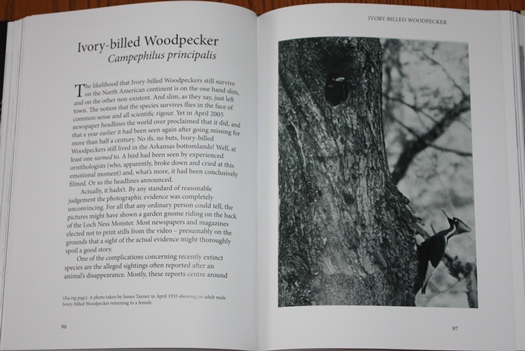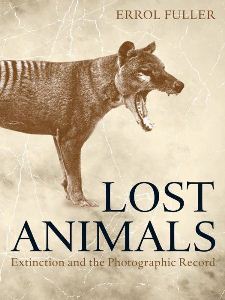Reviewed by Grant McCreary on March 23rd, 2014.
There is a singular feeling that you get when face-to-face with an extinct animal. Anyone who’s ever seen a Passenger Pigeon or Ivory-billed Woodpecker in a museum knows the feeling – an overwhelming, profound sense of loss. I’ve seen many wonderful paintings of extinct birds, made by talented artists from Audubon to Zickefoose. But nothing engenders as strong a feeling as a stuffed bird behind glass, even the ratty looking ones. The lone exception had been an extraordinary Grainger McKoy sculpture of Carolina Parakeets that moved me to tears. But now, I get that feeling every time I open Lost Animals: Extinction and the Photographic Record.
So, what’s different about this book? Photographs. Fuller noticed that people looking through his prior book, Extinct Birds, inevitably lingered on the few photographs. Most of these photos were fairly poor, but were more riveting than the much higher quality paintings that were the primary illustrations. He concluded that “a photograph of something lost or gone has a power all of its own, even though it may be tantalizingly inadequate”. Thus, the reason for Lost Animals, in which Fuller focuses on the last known – and in some cases, only – photographs ever to be taken of extinct species while they were still living.
Lost Animals includes 28 extinct species: 21 birds and 7 mammals. At first, I was surprised by the low number. After all, it’s an unfortunate fact that many more than 28 birds and mammals have gone extinct in the last 100 or so years. But in today’s world where almost everyone has in their pocket a camera of such quality that was unimaginable not all that long ago, it’s easy to forget that it has not always been that way. Photography of live animals wasn’t even feasible until sometime in the latter half of the 19th century, and wasn’t very practical until much later. And when you also consider that these animals were, obviously, rare and difficult to see at all, much less photograph, then the surprise is actually that there are enough photos to make a book such as this possible. Not only that, all but a handful of these animals have multiple pictures.

Most of the photos here are black-and-white, although a few of these animals hung on long enough to get captured via color photography. But even the color shots are, by today’s standards, not very good. They may be black-and-white, out of focus, or taken from too far away. But none of that matters. The concept of photographic quality goes right out the window when you’re looking at an image of not just a specific animal, but an entire species, that was once alive but is no more. What these pictures lack in quality they more than make up in impact.
However, the author realizes that some of these pictures don’t provide the reader with a satisfactory idea of how the animal really looked in life, especially in regard to coloration. To compensate for this, he includes a gallery of paintings as an appendix. All but a couple of the featured animals are included; those that are not are clearly depicted in a photo. These paintings include works by Audubon and Louis Agassiz Fuertes, as well as more obscure works. This gallery was a nice touch; it shows the animals from a different perspective, but without taking attention away from the photographs.
Short species accounts accompany the images. Fuller gives a very brief overview of the species and why it went extinct. I’ve always found this fascinating, if more than a little depressing. What I found even more interesting, and obviously unique to this book, are the stories behind the photos. When known, the author describes who took the pictures, when, where, and other interesting circumstances. In a few cases, he couldn’t uncover any of this, but that mystery is, in itself, intriguing.
Lost Animals makes a good introduction to these extinct species, but please be aware that these accounts aren’t meant to provide a full natural history (although I did find myself wishing for a bit more in that regard). Also, if you’re looking primarily for an introduction to extinct animals in general, not just the birds and mammals that were photographed, then I recommend A Gap in Nature: Discovering the World’s Extinct Animals.
Recommendation
Reading Lost Animals: Extinction and the Photographic Record is a reverential experience. Fuller is absolutely correct about the power of these photographs. I’m thankful that these vestiges of what we’ve squandered have been preserved, and now made available for all to see.
Here are the birds and mammals included in Lost Animals:
- Atitlán Giant Grebe
- Alaotra Grebe
- Pink-headed Duck
- Heath Hen
- Wake Island Rail
- Layson Rail
- Eskimo Curlew
- Passenger Pigeon
- Carolina Parakeet
- Paradise Parrot
- Laughing Owl
- Ivory-billed Woodpecker
- Imperial Woodpecker
- New Zealand Bush Wren
- Aldabra Brush Warbler
- Bachman’s Warbler
- Kaua ‘I ‘O’o
- ‘O’u
- Mamo
- Po’ouli
- Guam Flycatcher
- Thylacine
- Greater Short-tailed Bat
- Caribbean Monk Seal
- Yangtze River Dolphin
- Quagga
- Schomburgk’s Deer
- Bubal Hartebeest
Disclosure: I get a small commission for purchases made through links in this post.
Buy from NHBS
(based in the U.K.)
Disclosure: The item reviewed here was a complementary review copy provided by the publisher. But the opinion expressed here is my own, it has not been influenced in any way.






Great